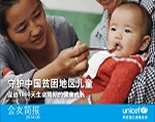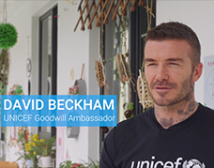NEW YORK, 1 January 2019 – An estimated 44,940 babies will be born in China on New Year's Day, UNICEF said today. Chinese babies will account for 11 per cent of the estimated 395,072 babies to be born on New Year's Day.
In cities around the world, revelers will welcome not only the New Year with great festivities but also their newest and tiniest residents. As the clock strikes midnight, Sydney will greet an estimated 168 babies, followed by 310 in Tokyo, 605 in Beijing, 166 in Madrid and finally, 317 in New York.
|

©UNICEF/UN0269296/Berkovich AFP-Services
On 1 January 2019 in China, newborn baby girl Li Xin Yao has her first diaper change. |
Fiji in the Pacific will most likely deliver 2019's first baby; the United States, its last. Around 1 in 5 of all babies will be born in East Asia and Pacific alone. Globally, over half of these births are estimated to take place in eight countries:
1. India — 69,944
2. China — 44,940
3. Nigeria — 25,685
4. Pakistan — 15,112
5. Indonesia — 13,256
6. The United States — 11086
7. The Democratic Republic of Congo — 10,053
8. Bangladesh — 8,428
Around the world on January 1, families will welcome countless Alexanders and Ayeshas, Zixuans and Zainabs. But in several countries, many babies will not even be named as they won't make it past their first day.
In 2017, about 1 million babies died the day they were born, and 2.5 million in just their first month of life. Among those children, most died from preventable causes such as premature birth, complications during delivery, and infections like sepsis and pneumonia, a violation of their basic right to survival.
"This New Year Day, let's all make a resolution to fulfill every right of every child, starting with the right to survive," said Charlotte Petri Gornitzka, UNICEF Deputy Executive Director. "We can save millions of babies if we invest in training and equipping local health workers so that every newborn is born into a safe pair of hands."
2019 also marks the 30th anniversary of the adoption of the Convention on the Rights of the Child, which UNICEF will be commemorating with worldwide events throughout the year. Under the convention, governments committed to, among other things, taking measures to save every child by providing good quality health care.
|

©UNICEF/UN0269290/Berkovich AFP-Services
On 1 January 2019 in China, (left) mother Xu Hui rests with her newborn daughter Li Xin Yao. |
Over the past three decades, the world has seen remarkable progress in child survival, cutting the number of children worldwide who die before their fifth birthday by more than half. But there has been slower progress for newborns. Babies dying in the first month account for 47 per cent of all deaths among children under five.
UNICEF's Every Child Alive campaign calls for immediate investment to deliver affordable, quality health care solutions for every mother and newborn. These include a steady supply of clean water and electricity at health facilities, the presence of a skilled health attendant during birth, ample supplies and medicines to prevent and treat complications during pregnancy, delivery and birth, and empowered adolescent girls and women who can demand better quality of health services.
"China has made enormous progress on reducing the number of mothers and children dying by increasing access to high quality primary health care across the country. However, newborn deaths, which account for about 50 per cent of all deaths among children under five years,are still a challenge. UNICEF has worked and will continue to work in partnership with the Government of China to ensure every birth occurs with skilled birth attendance, ending preventable newborn deaths and stillbirths and making sure no child dies from a preventable cause," said Dr. Douglas Noble, UNICEF Deputy Representative to China.
###
Notes to Editors
For complete un-rounded estimates on births and life expectancy for 190 countries, click here.For top ten baby names across 20 countries and number of births across 26 cities, click here.For the data, UNICEF worked with the World Data Lab.
The estimates for the number of babies born draw on the period indicators and the life tables of the UN's World Population Prospects (2017). Building on these datasets, World Data Lab's (WDL) algorithm projects the number of births for each day by country and their corresponding life expectancy. Similar methods were applied to compute the number of babies born in specific US and international cities as well as the regional estimates. Other data sources include UN Data, different US governmental services, and national statistics across several countries.
To download photos or video to accompany this story, click here. For photos of 12 New Year's babies from 12 time zones, click here(available only by 2 January 2019).
About UNICEF
UNICEF works in some of the world's toughest places, to reach the world's most disadvantaged children. Across 190 countries and territories, we work for every child, everywhere, to build a better world for everyone.
For more information, please contact:
Liu Li, UNICEF China, Tel:+86 10 85312612,Email:liliu@unicef.org































